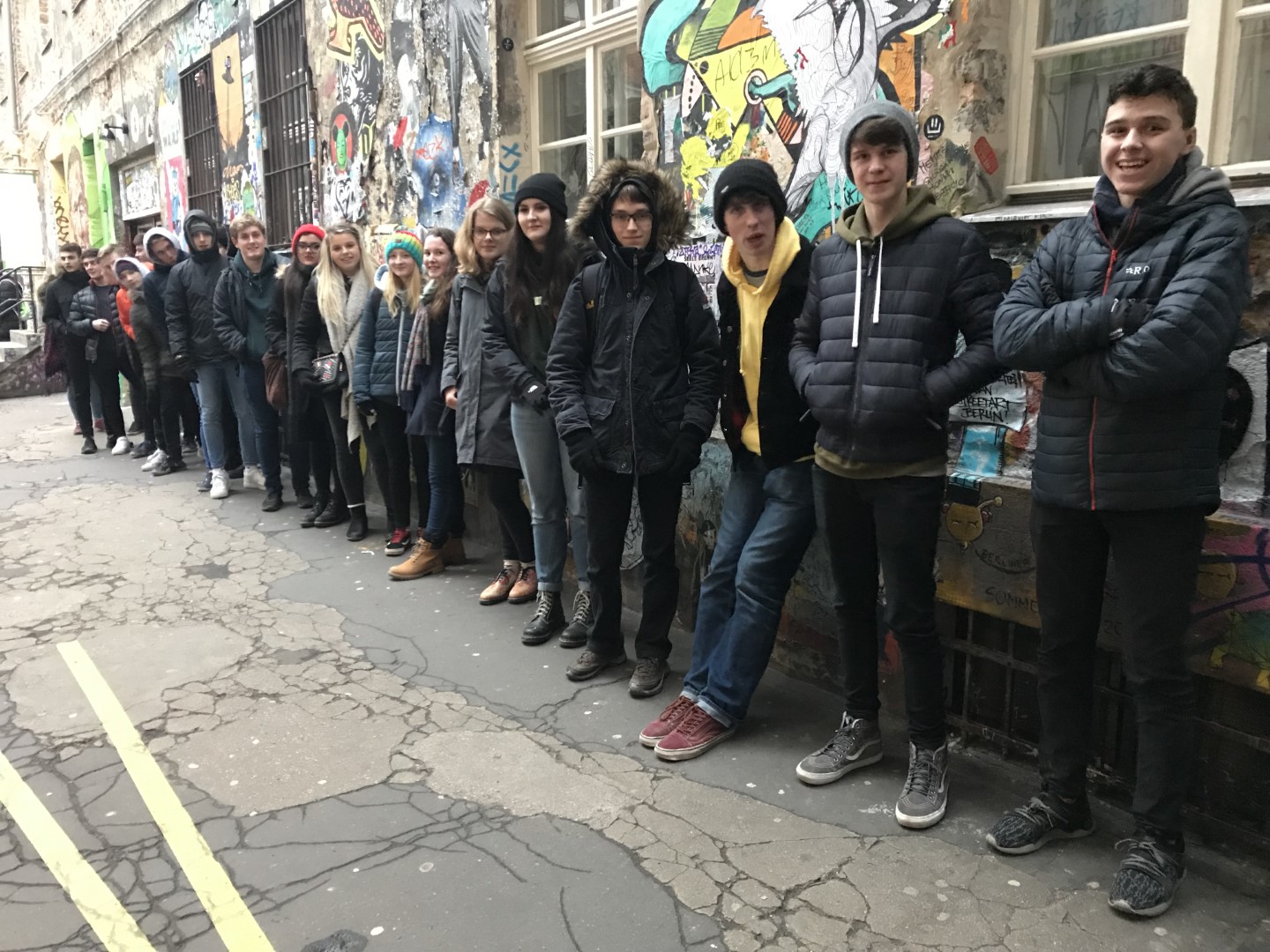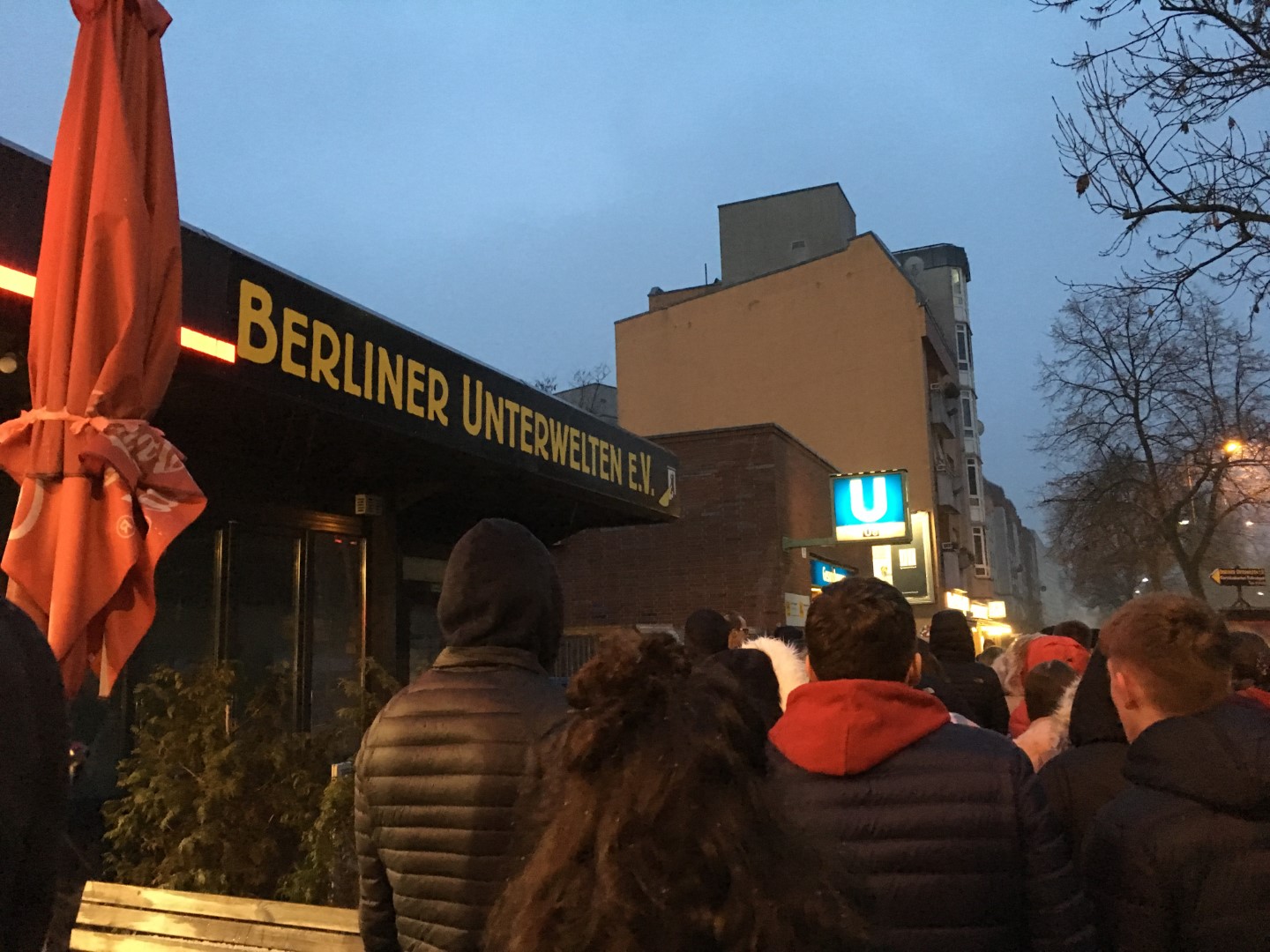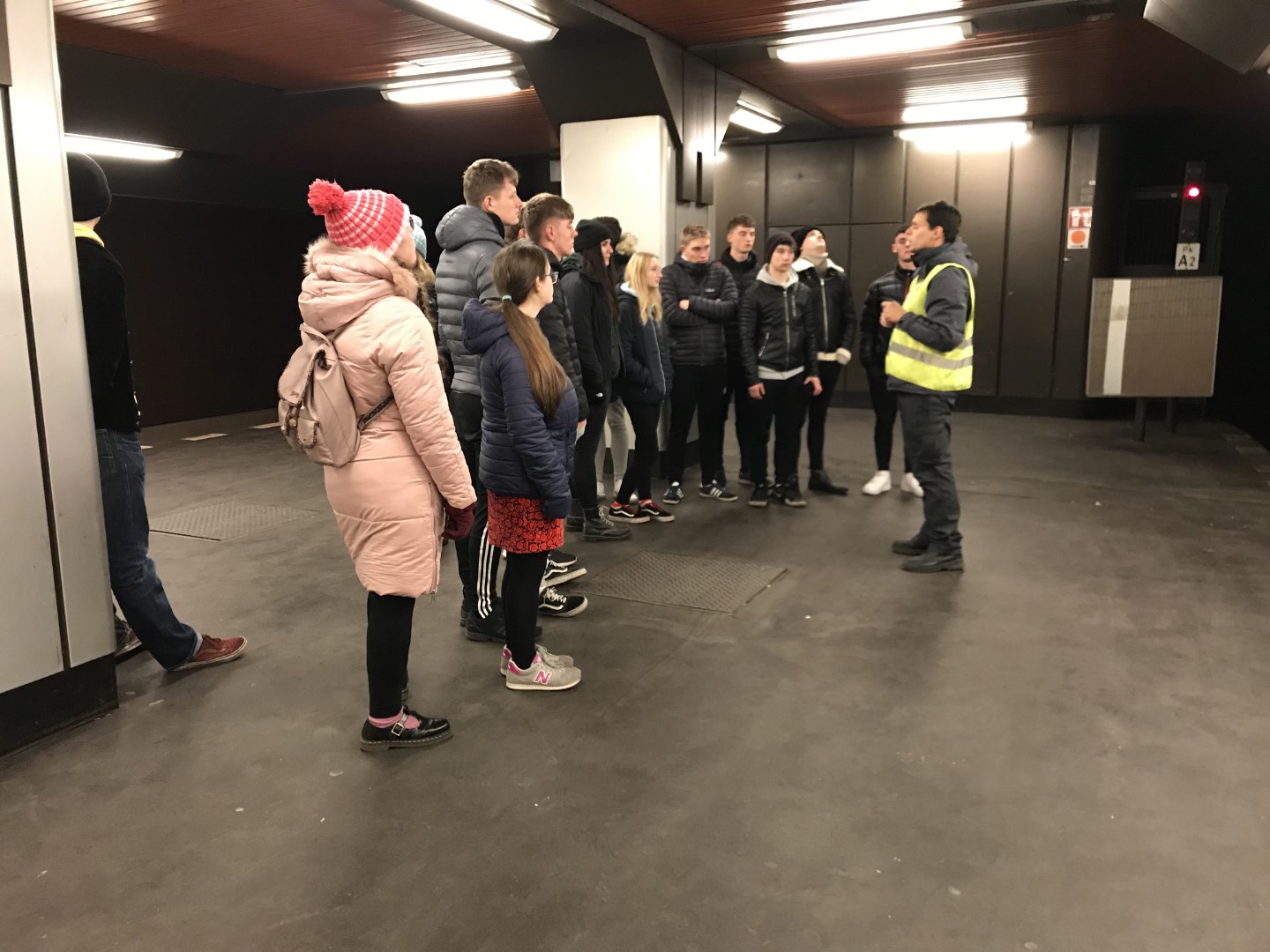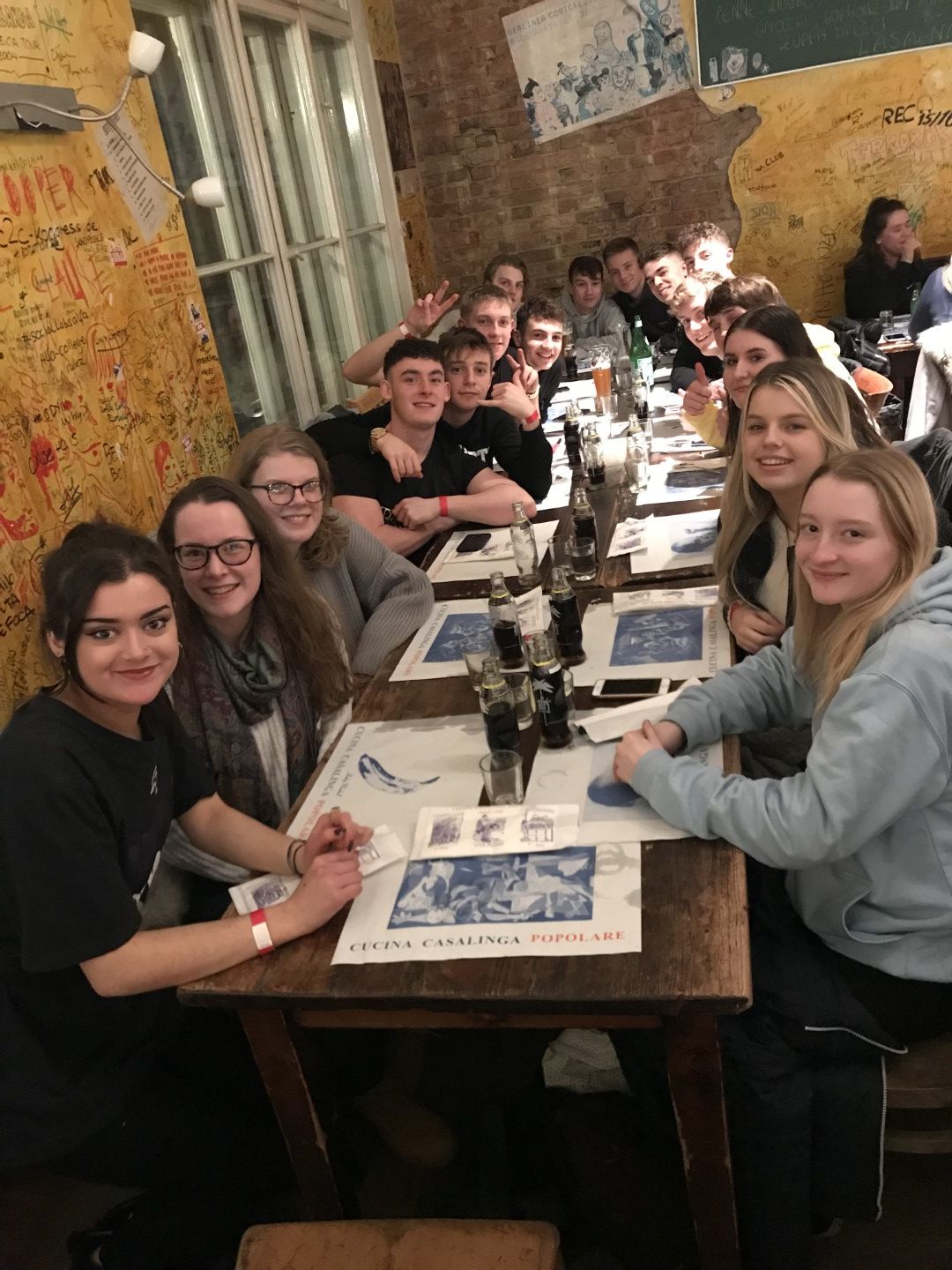Sixth Form Berlin History and German Trip
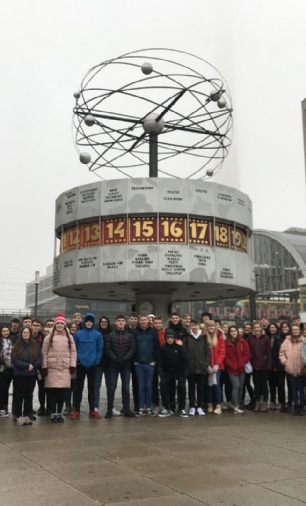
The Sixth Form German and History students travelled to Berlin in the early hours of Saturday 2nd February and had an action packed five days. Here are some of our students’ experiences of the trip.
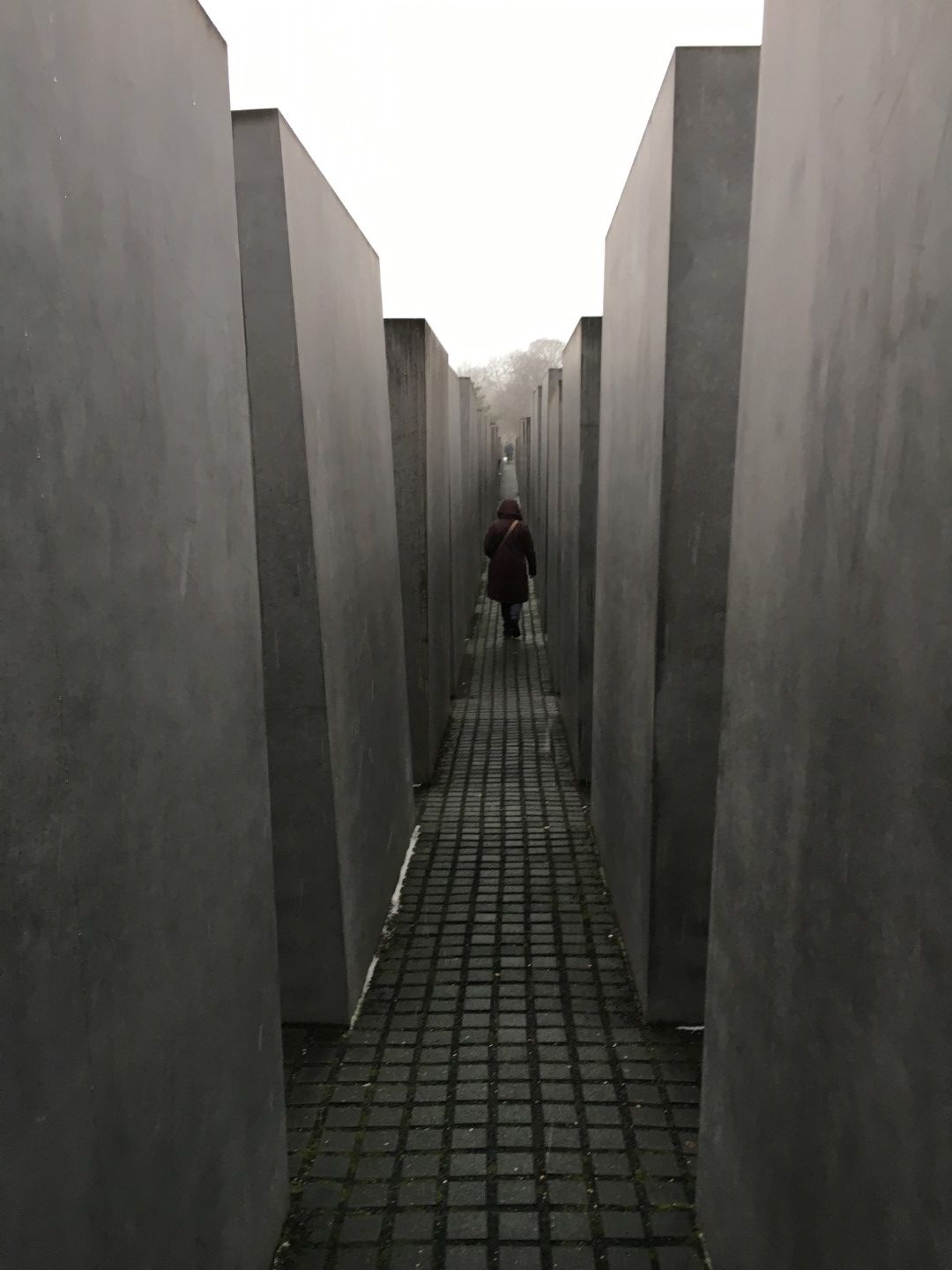 On the first day we visited the Memorial to the Murdered Jews of Europe. It consists of grey concrete slabs all in different heights. The architect made this memorial with no explanation of what it’s supposed to represent, however he wants people to give it their own interpretation. My thoughts were that it could represent all the Jews, they’re all different, for example different looks and jobs however they are all seen as the same. We all walked around it to give it our own place of mind. It was quite intense for some of us but interesting to see, also how some people act around it, some were running around or taking pictures which I thought was quite disrespectful. It was definitely a good experience. - Ella
On the first day we visited the Memorial to the Murdered Jews of Europe. It consists of grey concrete slabs all in different heights. The architect made this memorial with no explanation of what it’s supposed to represent, however he wants people to give it their own interpretation. My thoughts were that it could represent all the Jews, they’re all different, for example different looks and jobs however they are all seen as the same. We all walked around it to give it our own place of mind. It was quite intense for some of us but interesting to see, also how some people act around it, some were running around or taking pictures which I thought was quite disrespectful. It was definitely a good experience. - Ella
Following the memorial we visited the ‘Topography of Terror’, a museum which focuses on the SS and the Nazi secret police, the Gestapo, and the operations they carried out during the Nazi regime on the site of their head office buildings. The museum is based around a timeline of events (1939-1945) and includes sources such as quotes from both eyewitnesses and historians, which was very useful for some of our history coursework. The main exhibit covers how the Nazis dealt with their ideological and political enemies as well as prisoners of war. The museum also 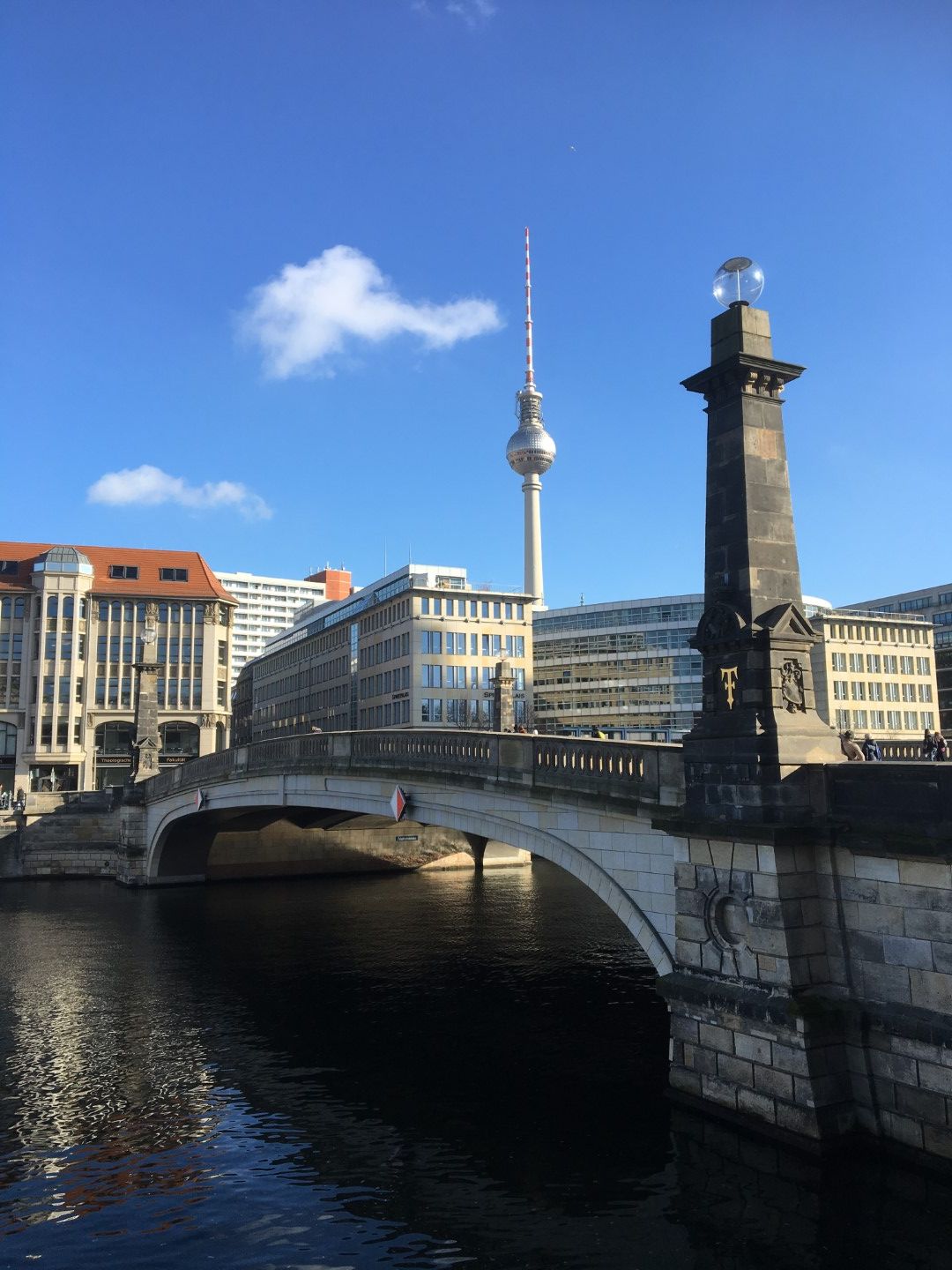 has a section focused on the events of Kristallnacht, the Night of Broken Glass, on 9th November 1938. On this night the Gestapo and civilians went around towns and cities destroying Jewish property including their synagogues. Outside the museum, below the the remaining sections of the Berlin Wall, there are the remains of the Gestapo headquarters. Only sections of the basement remain but they have been preserved. There are a few plaques describing what they were used for. It was an interesting experience. - Oliver and Victor
has a section focused on the events of Kristallnacht, the Night of Broken Glass, on 9th November 1938. On this night the Gestapo and civilians went around towns and cities destroying Jewish property including their synagogues. Outside the museum, below the the remaining sections of the Berlin Wall, there are the remains of the Gestapo headquarters. Only sections of the basement remain but they have been preserved. There are a few plaques describing what they were used for. It was an interesting experience. - Oliver and Victor
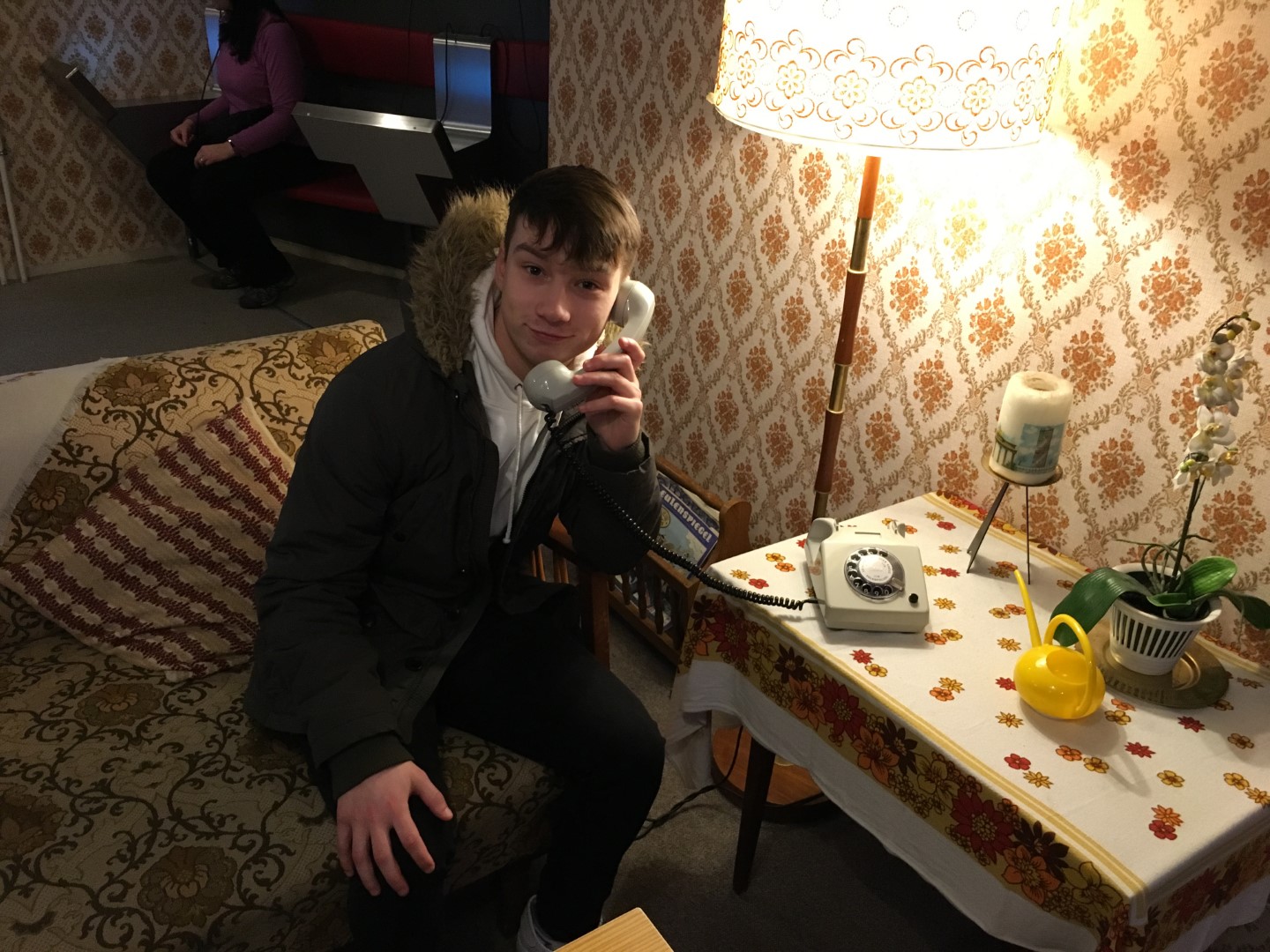 On Saturday evening we made a visit to the Berliner Unterwelten where we got first-hand experience of genuine underground nuclear bunkers which were used during the Cold War. We looked at two shelters, one which could be lived in for maximum of two days, and the other was for two weeks. The beds were no more than a thick bit of stretchy plastic, the toilets were a seat with a bin bag underneath, and you’d be lucky to see some lights on while you were living there. Despite the undesirable living conditions, the technology and engineering behind the shelters for the time were fascinating: air lock rooms were used to decontaminate the air for the people living there, and glow in the dark paint was used on the walls to direct inhabitants around the space. Threaded beneath and around the Berlin underground train system, the shelters were unbeknown to a large amount of Berlin civilians - they were kept very secretive as they weren’t bomb-proof bunkers so if a bomb were to land on them, all the temporary inhabitants would have no chance. An eye opening experience undoubtedly, made engaging further with an evidently knowledgeable & entertaining tour guide, providing us with multiple laughs throughout. - Dan
On Saturday evening we made a visit to the Berliner Unterwelten where we got first-hand experience of genuine underground nuclear bunkers which were used during the Cold War. We looked at two shelters, one which could be lived in for maximum of two days, and the other was for two weeks. The beds were no more than a thick bit of stretchy plastic, the toilets were a seat with a bin bag underneath, and you’d be lucky to see some lights on while you were living there. Despite the undesirable living conditions, the technology and engineering behind the shelters for the time were fascinating: air lock rooms were used to decontaminate the air for the people living there, and glow in the dark paint was used on the walls to direct inhabitants around the space. Threaded beneath and around the Berlin underground train system, the shelters were unbeknown to a large amount of Berlin civilians - they were kept very secretive as they weren’t bomb-proof bunkers so if a bomb were to land on them, all the temporary inhabitants would have no chance. An eye opening experience undoubtedly, made engaging further with an evidently knowledgeable & entertaining tour guide, providing us with multiple laughs throughout. - Dan
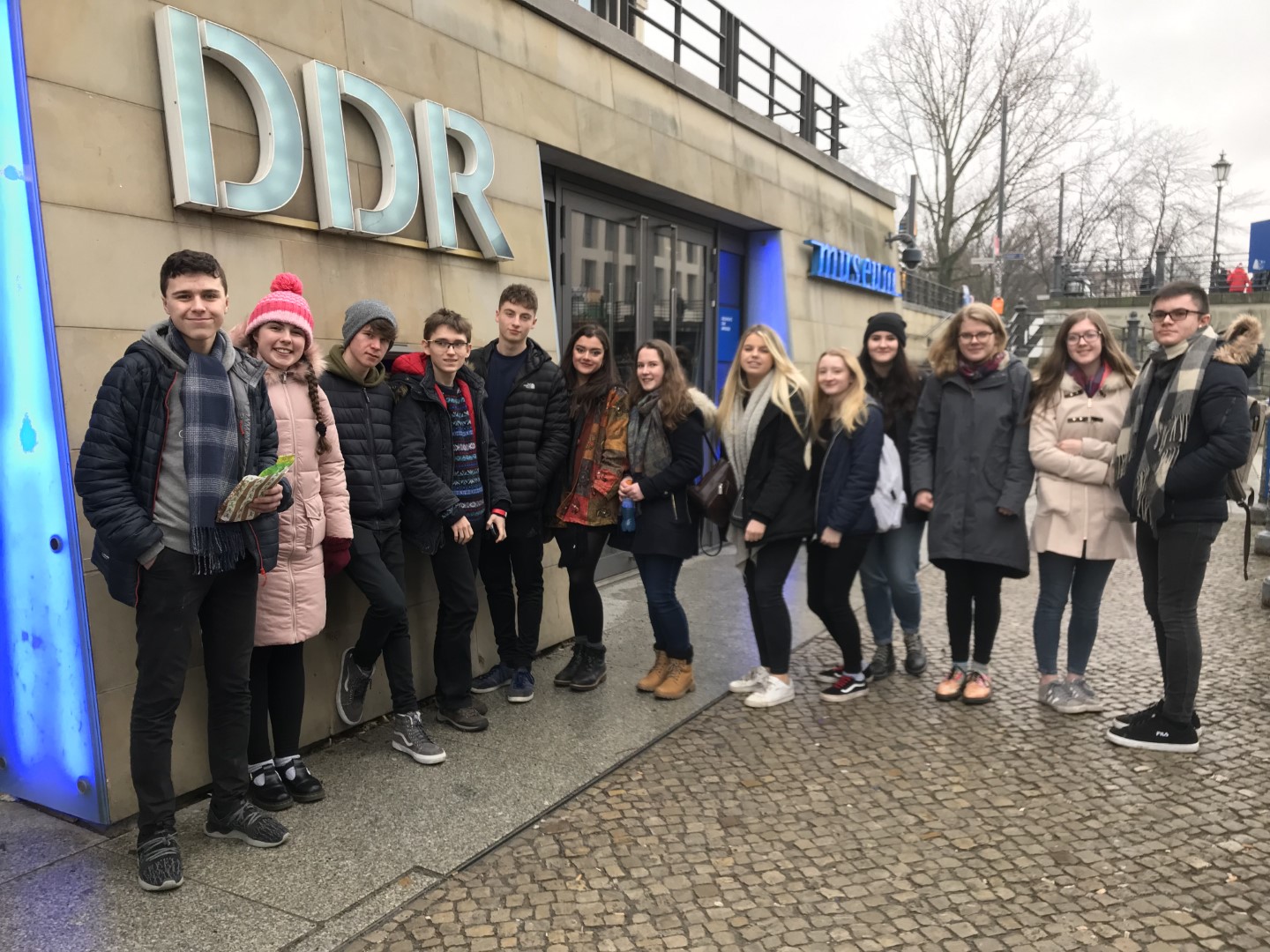 On the Sunday morning we visited the DDR (German Democratic Republic) museum which documents the lives of people living in East Germany. The exhibits included a replica of an East German flat in the 1960s using furnishings from the original homes. There were also presentations showing the economic problems, the organisation of the government, the education system and the use of the secret police (Stasi) to maintain control during the time of the separation. A highlight of the museum was the opportunity to drive a life-size model Trabant car in a simulation of
On the Sunday morning we visited the DDR (German Democratic Republic) museum which documents the lives of people living in East Germany. The exhibits included a replica of an East German flat in the 1960s using furnishings from the original homes. There were also presentations showing the economic problems, the organisation of the government, the education system and the use of the secret police (Stasi) to maintain control during the time of the separation. A highlight of the museum was the opportunity to drive a life-size model Trabant car in a simulation of 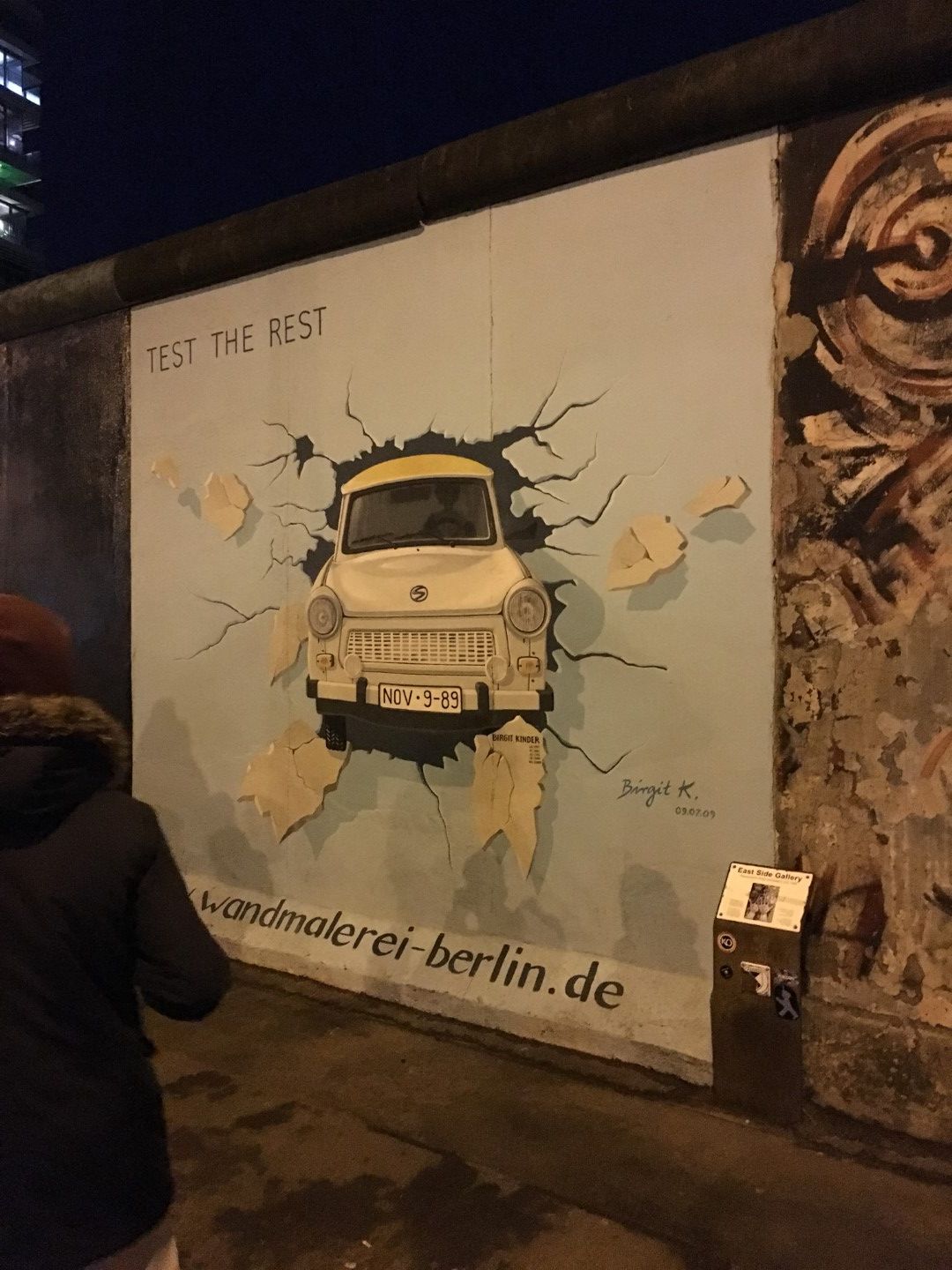 East Berlin, showing what the city looked like at the time. - Ruth and Molly
East Berlin, showing what the city looked like at the time. - Ruth and Molly
On Sunday we visited the DDR (GDR) Museum, where we had a guided tour around the majority of the museum before taking part in a Q&A with a civilian during the existence and fall of the Berlin Wall. Cristopher explained his personal story and experiences in relation to his life in East Berlin during the separation of the city, as well as detailing his experiences surrounding the destruction of the wall when he was 12 years old. Great questions from the group allowed Cristopher to thoroughly explain his personal experiences in East Germany, giving us a unique insight into the education system within the state as well as the prospects of escaping (mostly under the wall) and the continual threat of the Stasi. The engaging session was beneficial to us all; those studying History assessments about Germany in the Cold War period were able to ask questions and get a first-hand account and the German students, who have been studying life in the DDR in depth for their A Level studies, were able to gather information that will be useful in their speaking exams. Overall this opportunity was a very rewarding experience and I’m positive we are all grateful to have been able to take part in this Q&A. - Niall
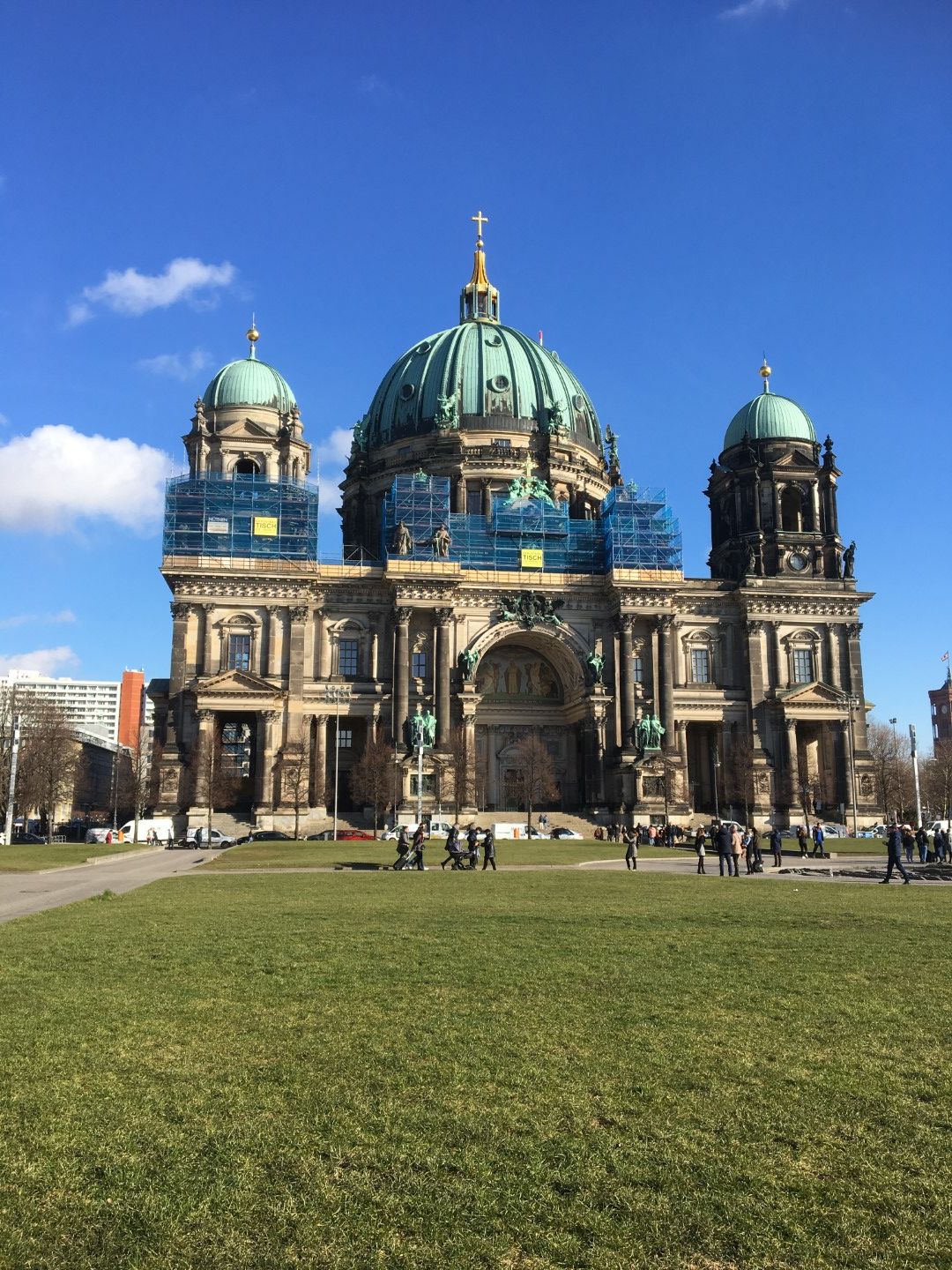 Mauerpark was one of the most genuine Berlin experiences of our trip as many locals go on Sundays to enjoy its great atmosphere. Although it was freezing, it was still incredibly busy! We were able to try traditional food including strudel and Currywurst which we could smell as soon as we walked in. There were many independent stalls which sold everything you can imagine and there was a flea market at the far side where we made some strange finds such as a pair of human teeth! - Starr
Mauerpark was one of the most genuine Berlin experiences of our trip as many locals go on Sundays to enjoy its great atmosphere. Although it was freezing, it was still incredibly busy! We were able to try traditional food including strudel and Currywurst which we could smell as soon as we walked in. There were many independent stalls which sold everything you can imagine and there was a flea market at the far side where we made some strange finds such as a pair of human teeth! - Starr
Later, we visited the Reichstag building. Having learned about influential buildings of Berlin, such as the Brandenburger Tor, the famous Charité hospital, and the various theatres, viewing the city from hundreds of metres in the air was fascinating. The bird's eye view not only brought our studying of Berlin to life, but it also developed our understanding of the metropolis: audio guides educated us about buildings in every direction we looked in. We ascended up the spiral staircase, which circles a huge mirrored cone, spiralling up towards the sky. It feels truly exciting to have had this 'Reichstag experience', and it was just one of the many unique adventures we enjoyed on the trip. - Bella
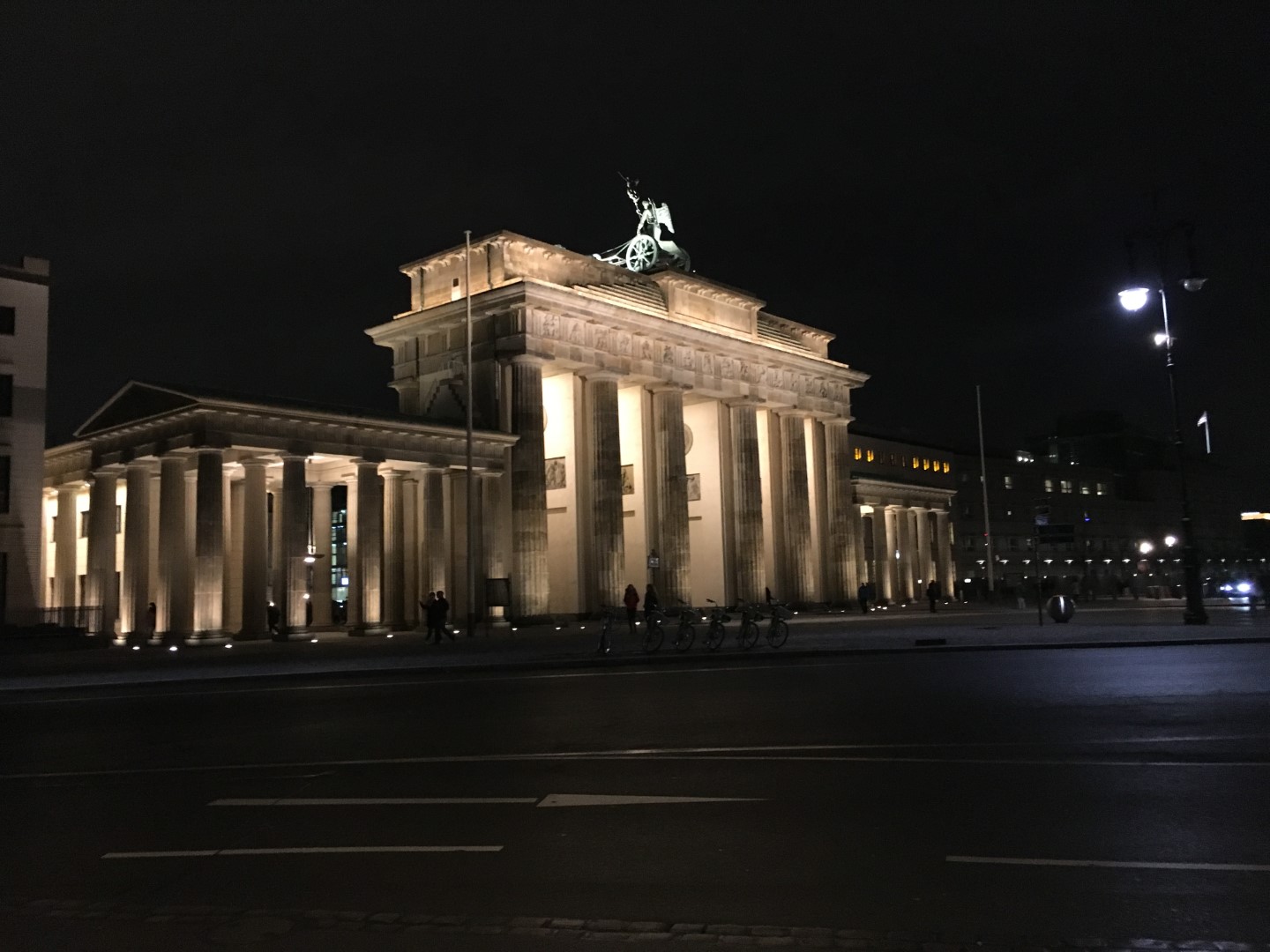 After visiting the Reichstag, we arrived at the famous Brandenburg Gate, which was as beautiful as it is historically significant, and made sure to take lots of pictures underneath it. Afterwards, we admired the exquisite architecture of institutions such as the Humboldt University surrounding Bebelplatz, an area where books were burned during the Nazi era. The evening was finished off with a night-time bus tour of the city and all of its famous as well as lesser-known attractions, like Berlin’s largest roundabout and former location of the Berlin Love Parade; this was also our first visit to the ominous Checkpoint Charlie from the era of divided Germany. Everyone found the tour extremely interesting, with our tour guide Axel providing lots of helpful and fascinating information, and it was a great way to see everything we possibly could in Berlin. - Sophia
After visiting the Reichstag, we arrived at the famous Brandenburg Gate, which was as beautiful as it is historically significant, and made sure to take lots of pictures underneath it. Afterwards, we admired the exquisite architecture of institutions such as the Humboldt University surrounding Bebelplatz, an area where books were burned during the Nazi era. The evening was finished off with a night-time bus tour of the city and all of its famous as well as lesser-known attractions, like Berlin’s largest roundabout and former location of the Berlin Love Parade; this was also our first visit to the ominous Checkpoint Charlie from the era of divided Germany. Everyone found the tour extremely interesting, with our tour guide Axel providing lots of helpful and fascinating information, and it was a great way to see everything we possibly could in Berlin. - Sophia
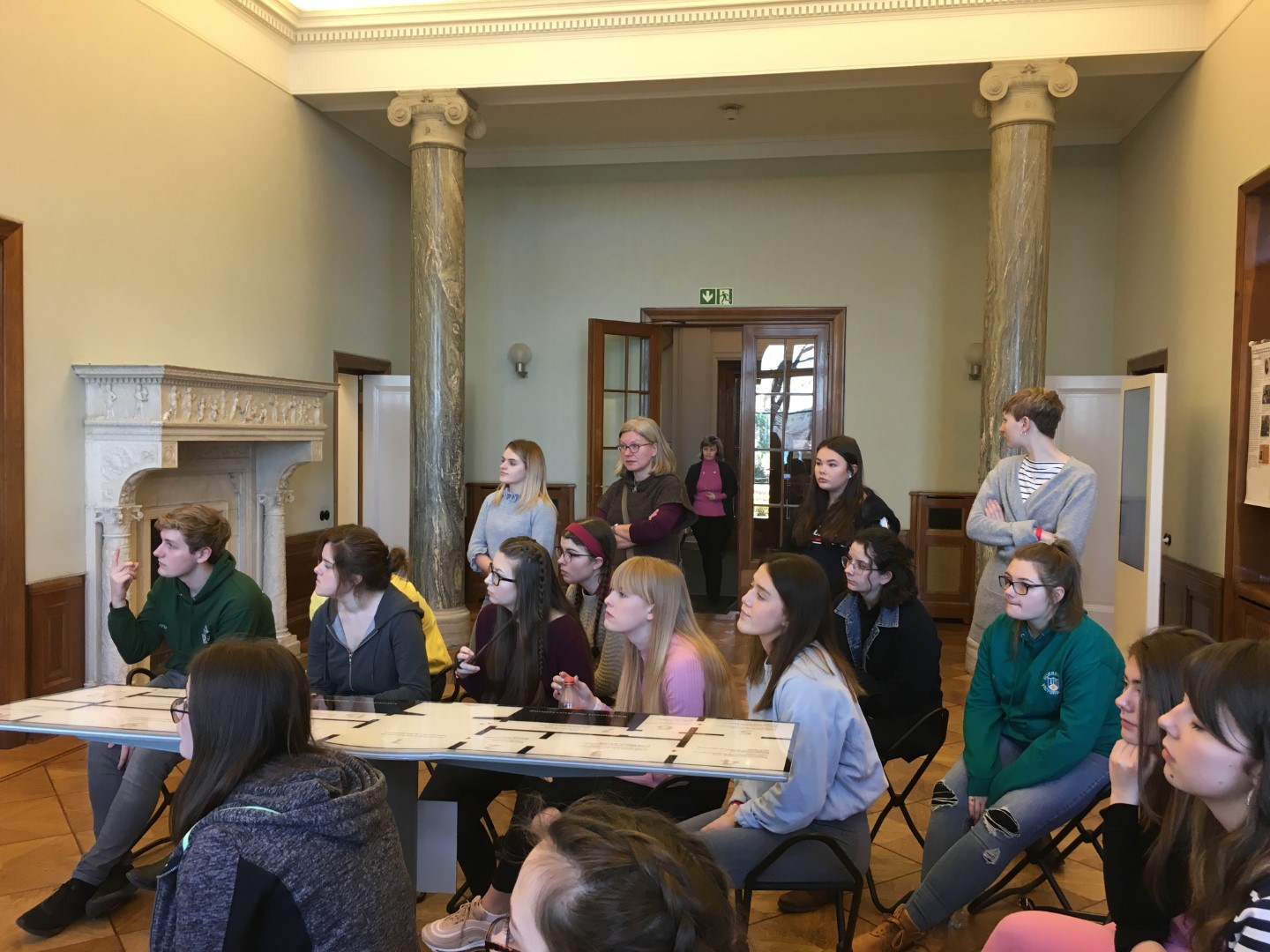 On Monday, the history group attended the Haus der Wannsee Konferenz in West Berlin to learn about the Anti-Semitism during World War 2 and the significance of the Final Solution. Throughout the day, we engaged in activities as a group with our tour guide Aliscia. During the morning we learnt about the final solution which was the decision to carry out the mass extermination of the Jews in January 1942. It was interesting to learn that the conference making this decision was essentially just a reorganisation of the process, as mass murder was already being carried out before this time. We all enjoyed the group discussion and the activities allowed us all to express our opinions on the subject.
On Monday, the history group attended the Haus der Wannsee Konferenz in West Berlin to learn about the Anti-Semitism during World War 2 and the significance of the Final Solution. Throughout the day, we engaged in activities as a group with our tour guide Aliscia. During the morning we learnt about the final solution which was the decision to carry out the mass extermination of the Jews in January 1942. It was interesting to learn that the conference making this decision was essentially just a reorganisation of the process, as mass murder was already being carried out before this time. We all enjoyed the group discussion and the activities allowed us all to express our opinions on the subject. 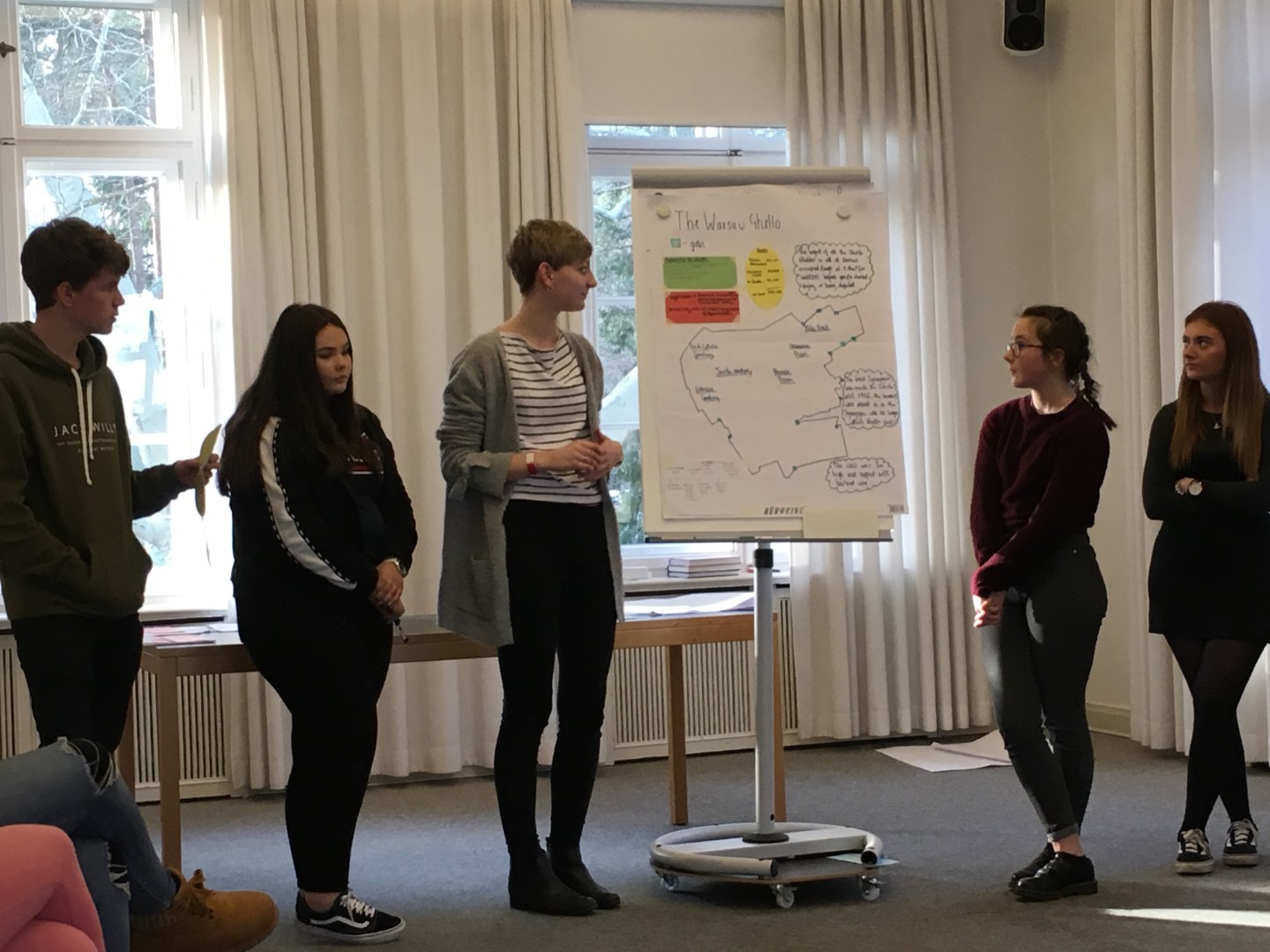 The first part of the day included a tour of the memorial museum where were able to visit the room in which the conference took place and also see important documents from the time. Aliscia explained the roles of the 16 men who attended the conference and it was a great experience to be able to hear an in-depth account of such a widely studied historical event.
The first part of the day included a tour of the memorial museum where were able to visit the room in which the conference took place and also see important documents from the time. Aliscia explained the roles of the 16 men who attended the conference and it was a great experience to be able to hear an in-depth account of such a widely studied historical event.
During the afternoon we were split into 6 groups and each group was given the task of creating a presentation on one section of the persecution process. My group focused on the deportation of the Jews, which allowed us to read real historical documents and accounts about what the Jews encountered whilst on their way to the extermination camps. The research was a good way of helping everyone read, first hand, what happened during this time.
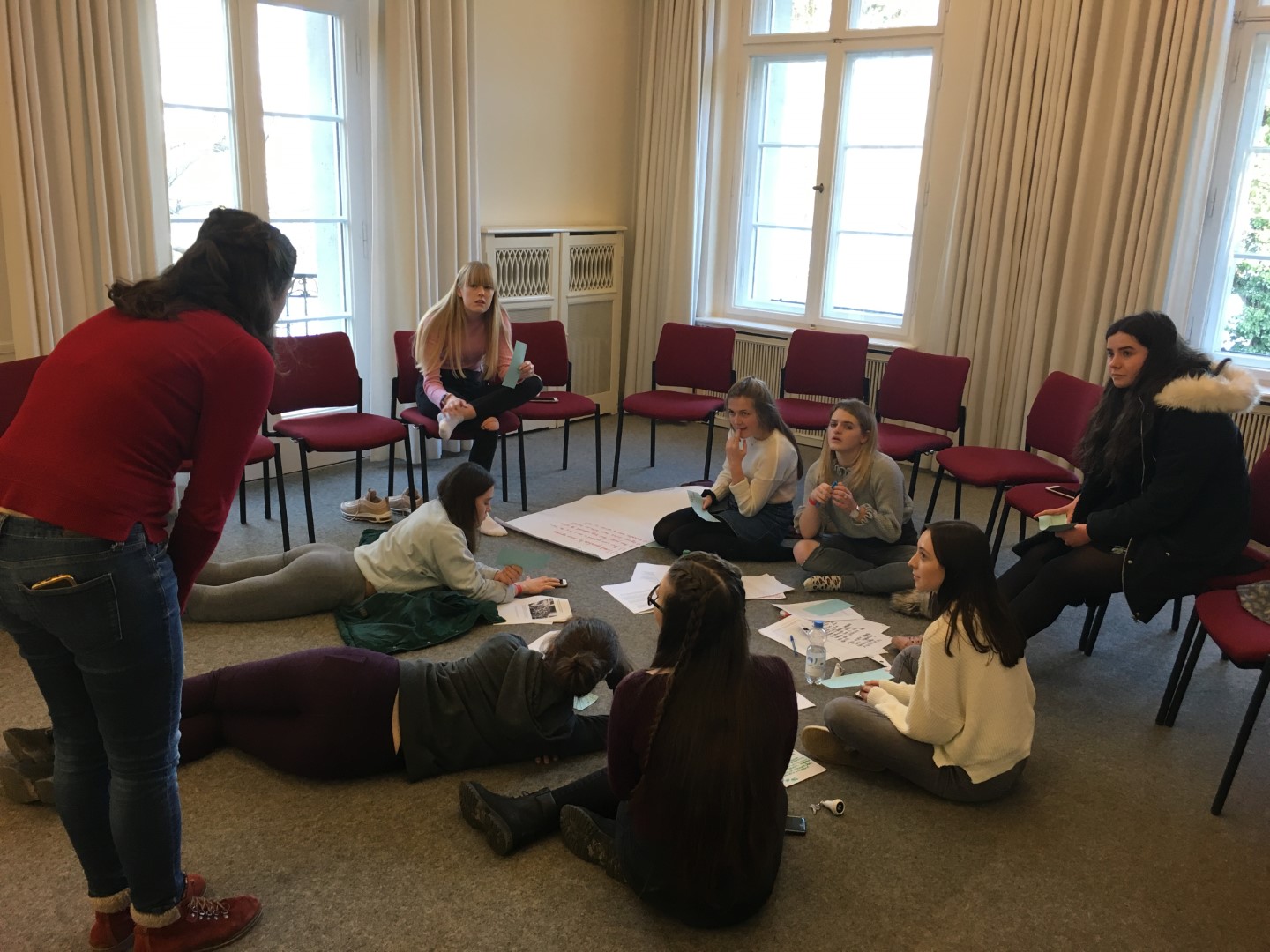 Our day at the Wannsee Konferenz was a very insightful and interactive day for everyone in the history group, but it was especially helpful to the students in Year 13 studying Anti-Semitic ideas in Germany being the main cause of the Holocaust for their assessments, because they were able to gain primary and secondary information to include in their final write up. - Beth
Our day at the Wannsee Konferenz was a very insightful and interactive day for everyone in the history group, but it was especially helpful to the students in Year 13 studying Anti-Semitic ideas in Germany being the main cause of the Holocaust for their assessments, because they were able to gain primary and secondary information to include in their final write up. - Beth
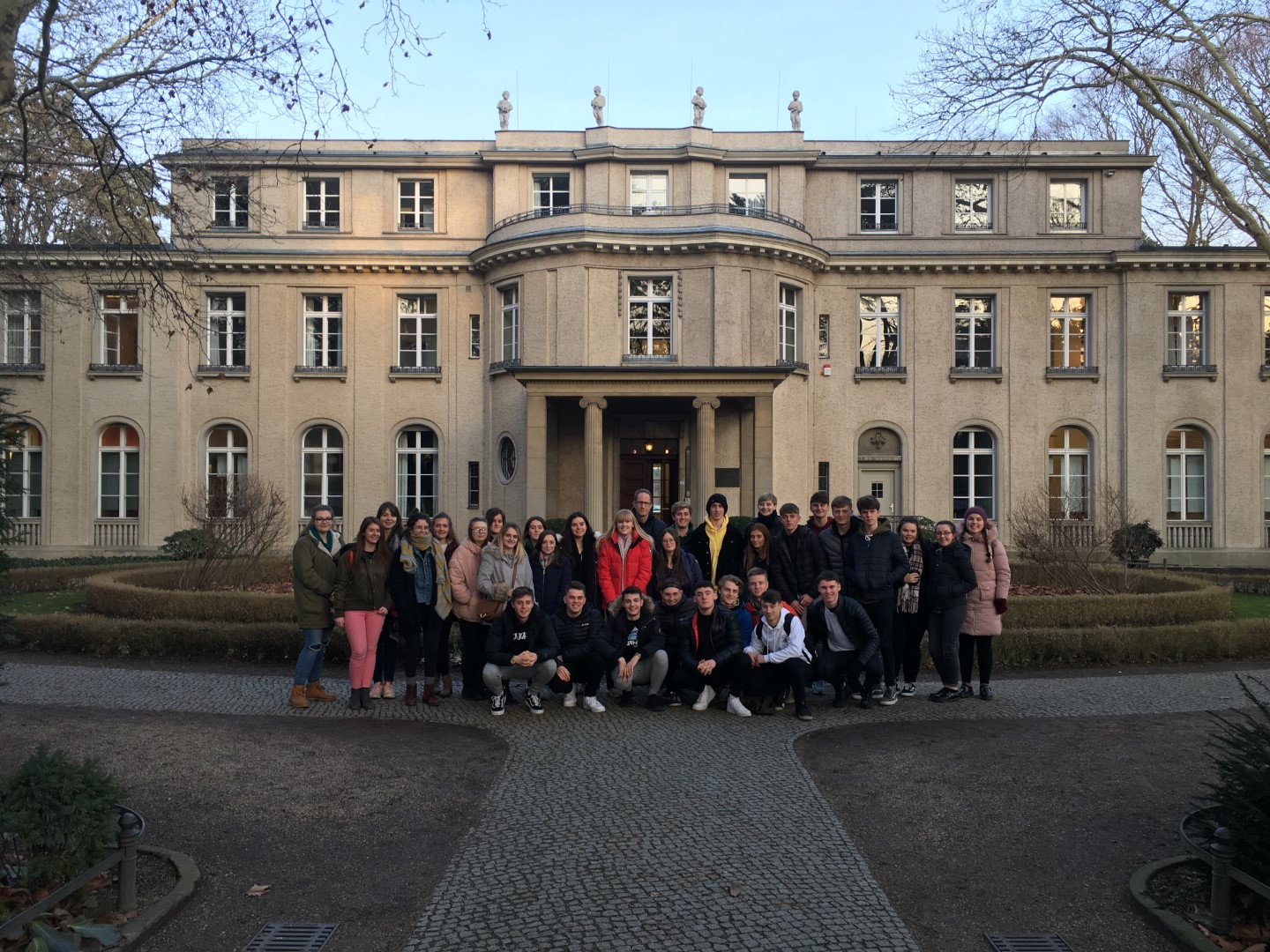 As part of our art and architecture unit, German students study Museum Island. On Monday morning we visited the island, and visited the specific buildings we learn about. With the blue sky and peaceful river Spree flowing by, this morning was perfect for a sunny walk, around all the sights we wanted to see. Not only did we develop our knowledge of Berlin’s architecture, but we also experienced just how significant the diversity of buildings is to the city. It was a really enjoyable way of refining our ideas of art and architecture. - Lucy
As part of our art and architecture unit, German students study Museum Island. On Monday morning we visited the island, and visited the specific buildings we learn about. With the blue sky and peaceful river Spree flowing by, this morning was perfect for a sunny walk, around all the sights we wanted to see. Not only did we develop our knowledge of Berlin’s architecture, but we also experienced just how significant the diversity of buildings is to the city. It was a really enjoyable way of refining our ideas of art and architecture. - Lucy
On Monday afternoon our German class met a Berlin graffiti artist called Curtis, who first started doing graffiti in New York at the age of twelve. He showed us lots of graffiti and street art in the area, and explained the different types of art and how the community works. After that, we went to a warehouse to do some of our own graffiti. We started by cutting out stencils, then he showed us how to use spray cans to first make a background, then layer our stencil and create a design. We could use any colours and stencils to create whatever we wanted, and I loved that at the end we all came out with something completely unique, even though we’d never tried anything like it before. - Heather B
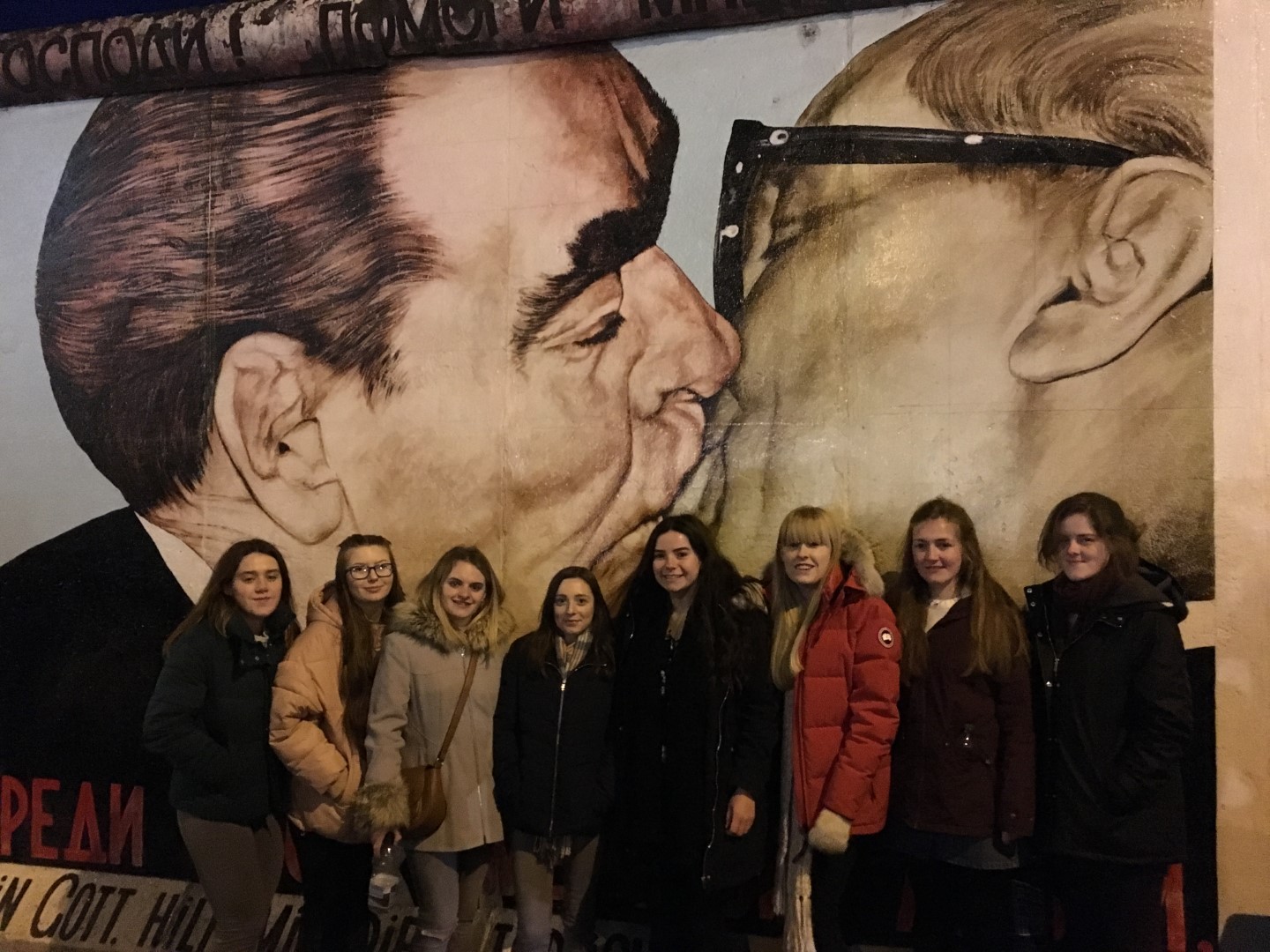 We then visited the East Side Gallery. Shortly after the fall of the Berlin Wall, artists from many different countries came to create artwork on a stretch of the wall to represent unity between Germany and other countries. It was officially opened as an outdoor gallery and is the longest surviving stretch of the wall, featuring many famous works of art such as the ‘Fraternal Kiss’ and a copy of this can be seen at school in the humanities department. My personal favourite was the painting of a dove freeing a chained hand, because it represents the freedom of the East-German people. - Hal
We then visited the East Side Gallery. Shortly after the fall of the Berlin Wall, artists from many different countries came to create artwork on a stretch of the wall to represent unity between Germany and other countries. It was officially opened as an outdoor gallery and is the longest surviving stretch of the wall, featuring many famous works of art such as the ‘Fraternal Kiss’ and a copy of this can be seen at school in the humanities department. My personal favourite was the painting of a dove freeing a chained hand, because it represents the freedom of the East-German people. - Hal
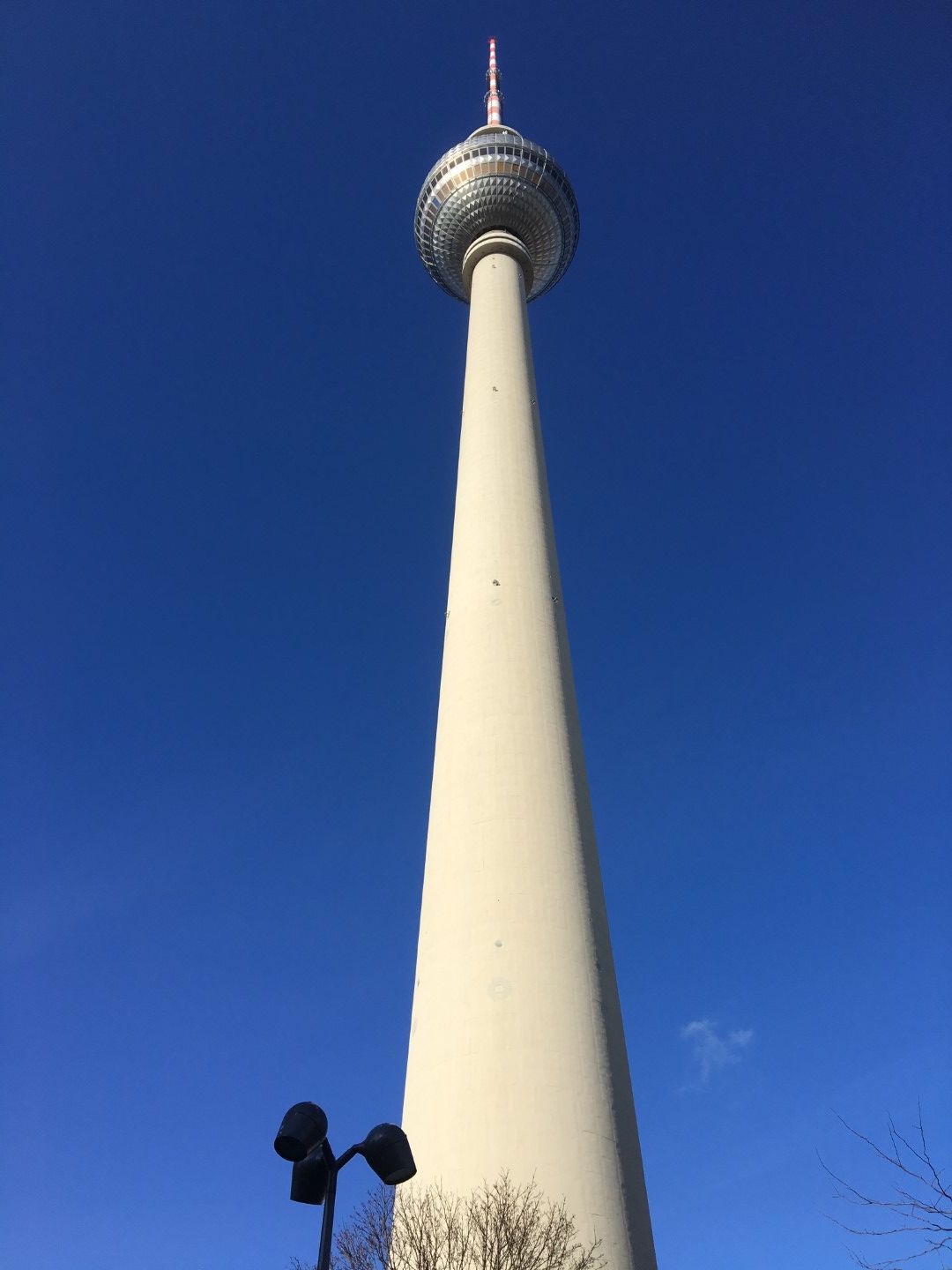 Throughout the trip we saw many landmarks of Berlin, but none of them came close to the TV tower, which we visited on the Monday evening. The tower dominates the Berlin skyline with its immense height of over 200 meters. The tower was first erected in the 1960s, when the GDR government arranged to have it built overlooking the western part of the city, with the aim of demonstrating the strength and efficiency of the socialist system. We travelled up in a lift and were able to witness the view of the city from the top. It was like nothing I’ve experienced before and definitely took my spot of the best experience of the trip. - Alex H
Throughout the trip we saw many landmarks of Berlin, but none of them came close to the TV tower, which we visited on the Monday evening. The tower dominates the Berlin skyline with its immense height of over 200 meters. The tower was first erected in the 1960s, when the GDR government arranged to have it built overlooking the western part of the city, with the aim of demonstrating the strength and efficiency of the socialist system. We travelled up in a lift and were able to witness the view of the city from the top. It was like nothing I’ve experienced before and definitely took my spot of the best experience of the trip. - Alex H
On Tuesday, we visited Sachsenhausen which is a concentration camp just outside of Berlin. As many of us had never been to a concentration camp before, we were nervous about what to 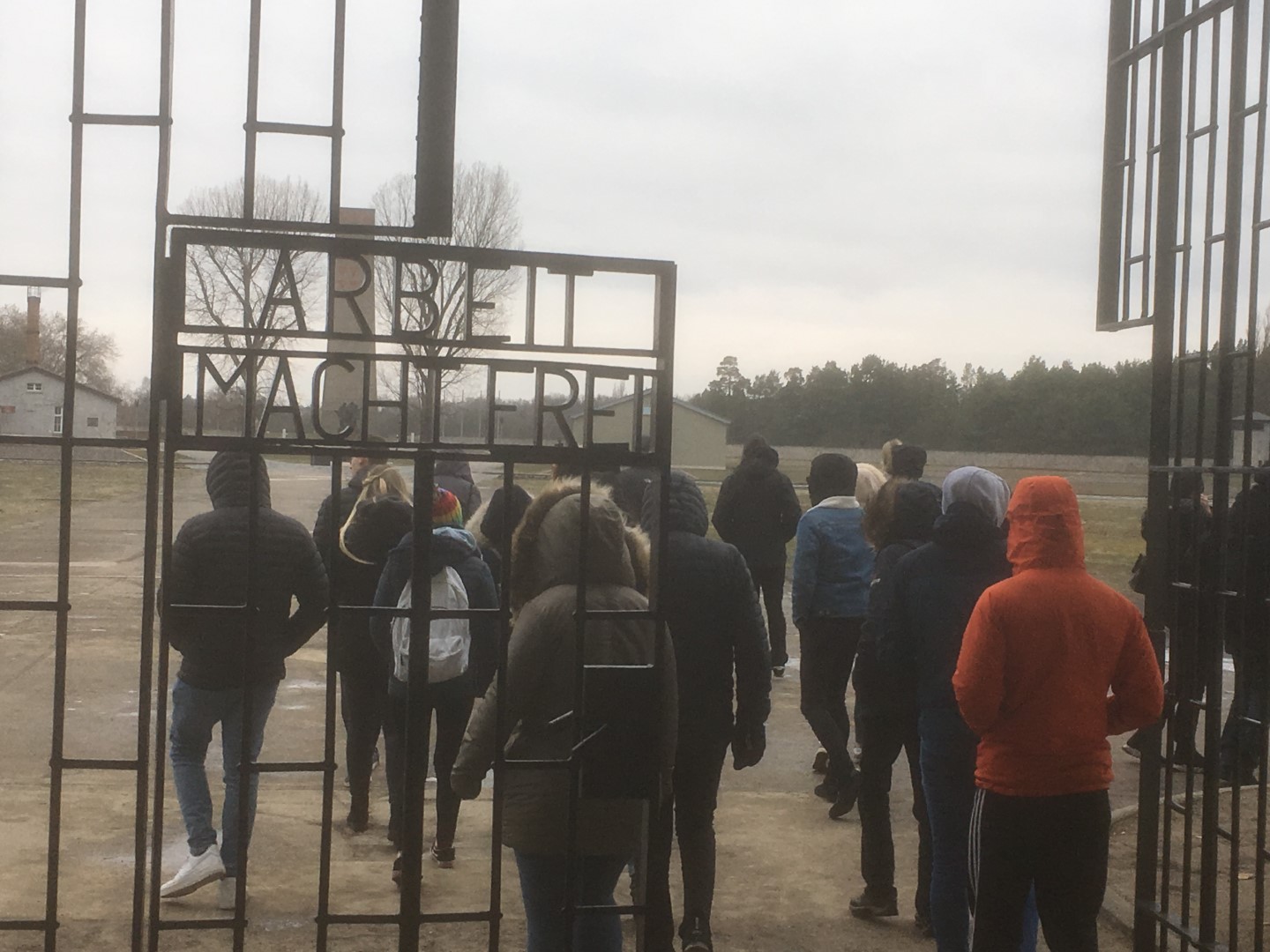 expect. One of the first things we saw was the German phrase “Arbeit Macht Frei” stated by Himmler in 1939 which translates to “work sets you free”. We really got a feel for some of the conditions they faced on a day to day basis due to the bitter cold. Although we were all wrapped up in many layers, the cold affected our moods massively so it was easy to empathise with the prisoners of war who endured this weather daily with a lot fewer layers. It was an emotional day as we learnt of all the horrific things which took place here and some of us were surprised to learn that gas chambers were not used regularly here. However this by no means meant that these prisoners suffered any less than in other places as well over 30 000 people lost their lives here.
expect. One of the first things we saw was the German phrase “Arbeit Macht Frei” stated by Himmler in 1939 which translates to “work sets you free”. We really got a feel for some of the conditions they faced on a day to day basis due to the bitter cold. Although we were all wrapped up in many layers, the cold affected our moods massively so it was easy to empathise with the prisoners of war who endured this weather daily with a lot fewer layers. It was an emotional day as we learnt of all the horrific things which took place here and some of us were surprised to learn that gas chambers were not used regularly here. However this by no means meant that these prisoners suffered any less than in other places as well over 30 000 people lost their lives here.
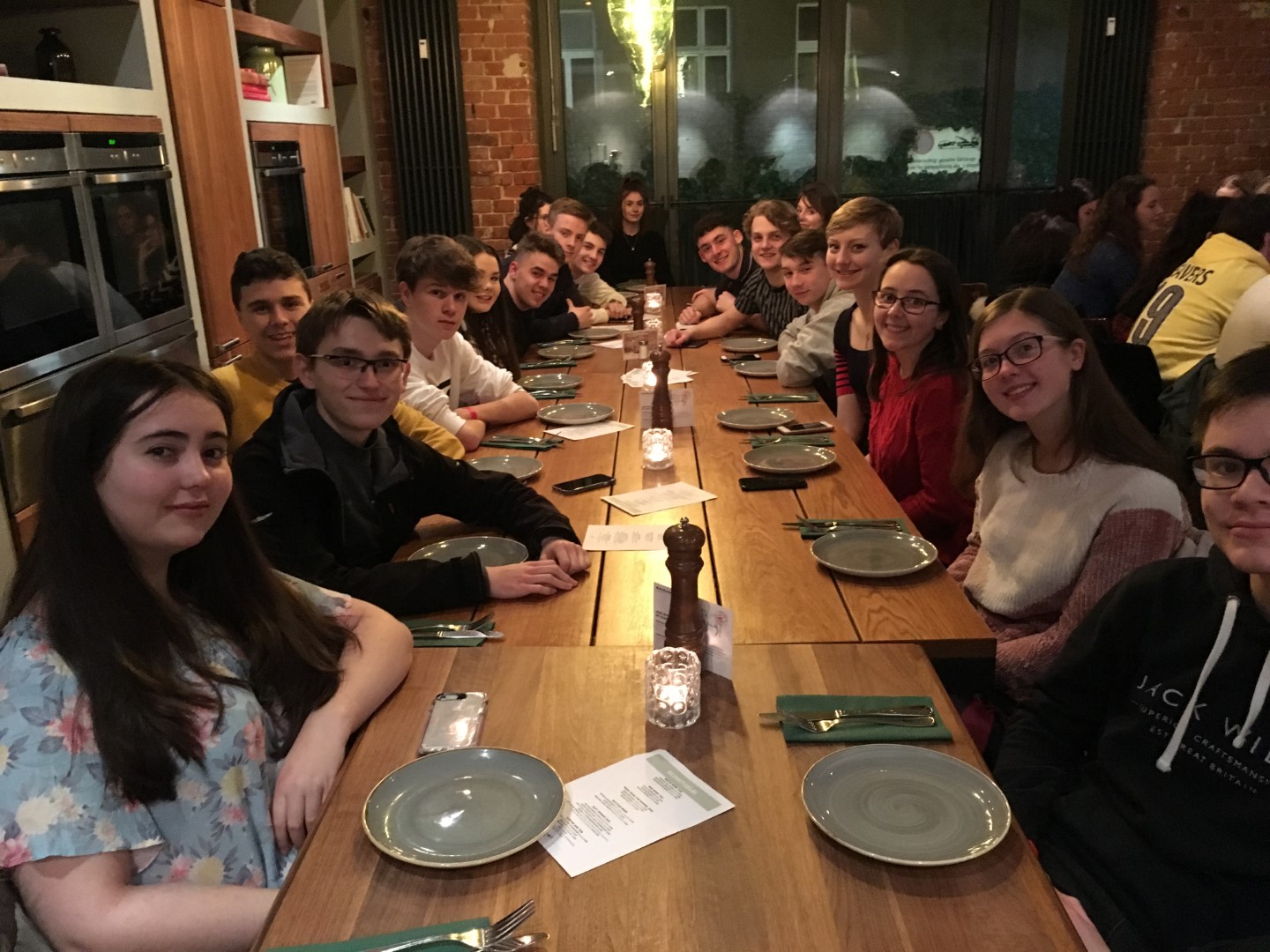 On the final night the students were able to try out a range of German delicacies including blood sausage, sauerkraut, currywurst and schnitzel, and it is fair to say some enjoyed this more than others!
On the final night the students were able to try out a range of German delicacies including blood sausage, sauerkraut, currywurst and schnitzel, and it is fair to say some enjoyed this more than others!
Overall, the trip was a hugely rewarding experience and our German and History students have learnt a great deal from it, as their writing shows.

